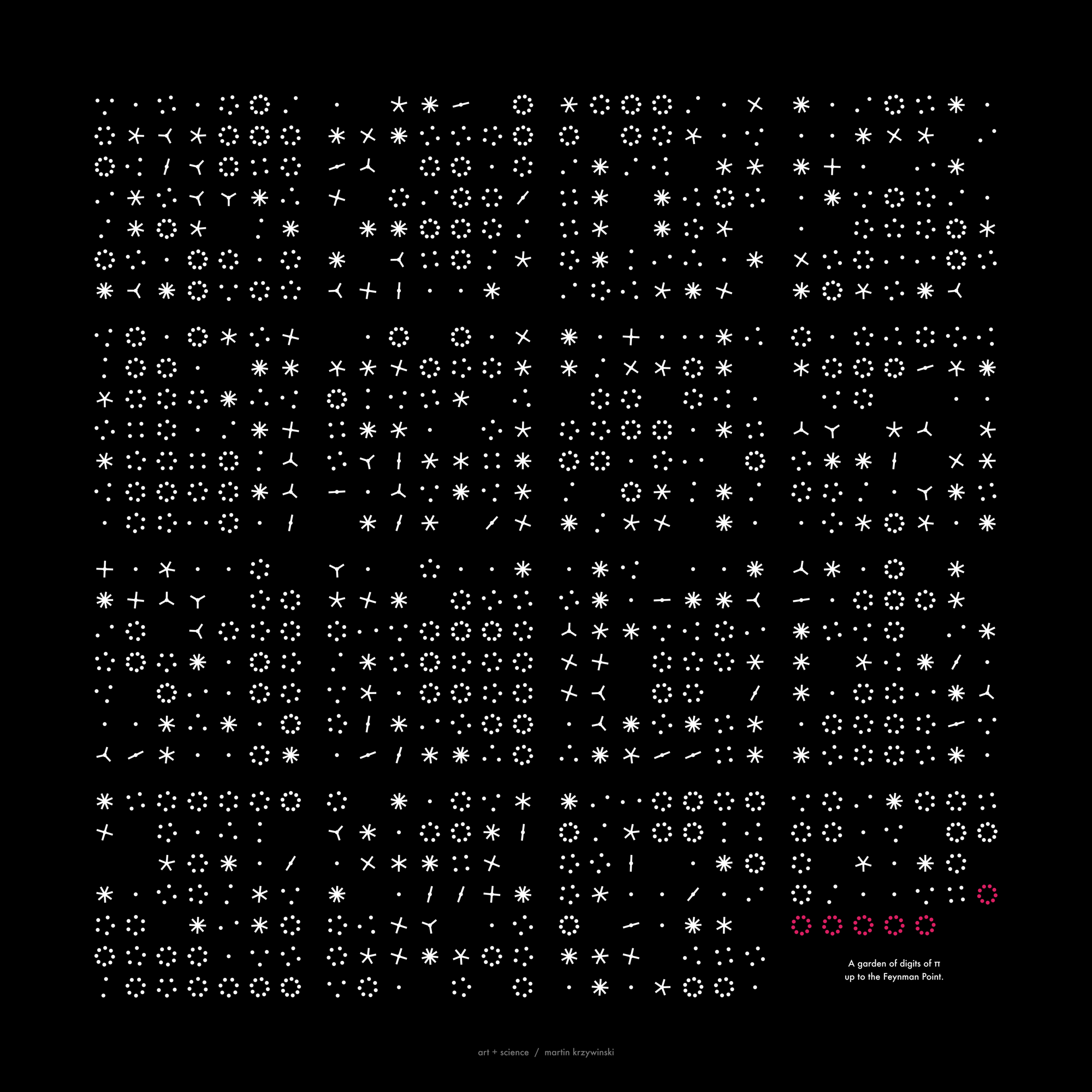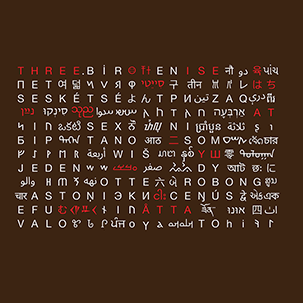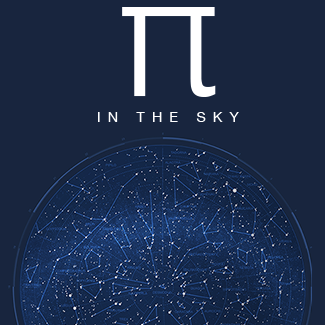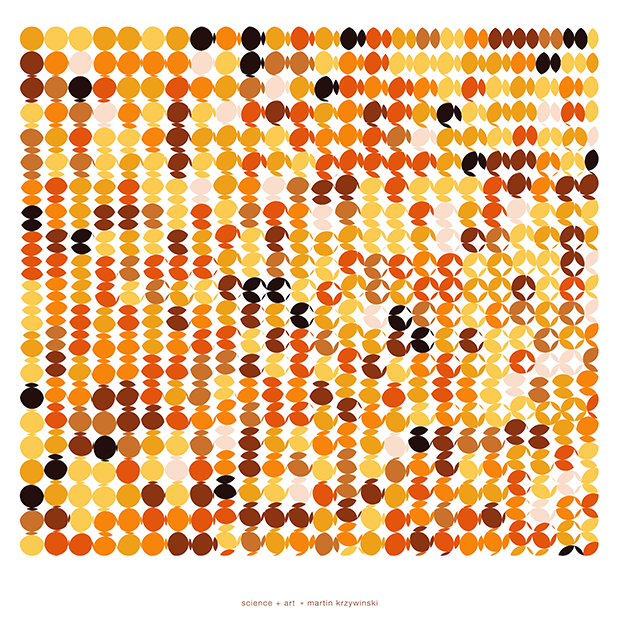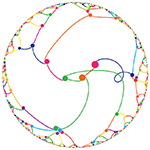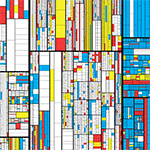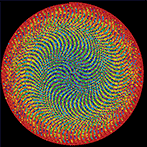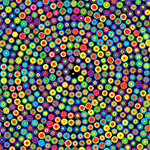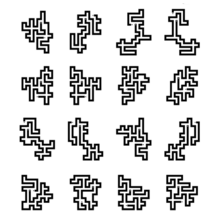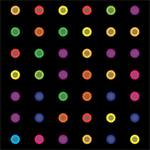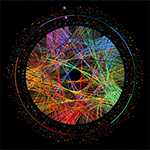The art of Pi (`\pi`), Phi (`\phi`) and `e`
Numbers are a lot of fun. They can start conversations—the interesting number paradox is a party favourite: every number must be interesting because the first number that wasn't would be very interesting! Of course, in the wrong company they can just as easily end conversations.
is π normal?
It is not yet known whether the digits of π are normal—determining this is an important problem in mathematics. In other words, is the distribution of digit frequencies in π uniform? Do each of the digits 0–9 appear exactly 1/10th of the time, does every two-digit string appear exactly 1/100th of the time and so on for every finite-length string1?
1 One interesting finite-length string is the 6-digit Fenyman Point (...999999...) which appears at digit 762 in π. The Feynman Point was the subject of 2014 `\pi` Day art.
This question can be posed for different representations of π—in different bases. The distribution frequencies of 1/10, 1/100, and so on above refer to the representation of π in base 10. This is the way we're used to seeing numbers. However, if π is encoded as binary (base 2), would all the digits in 11.00100100001111... be normal? The table below shows the first several digits of π in each base from 2 to 16, as well as the natural logarithm base, `e`.
| base, `b` | `\pi_b` | base, `b` | `\pi_b` |
| 2 | 11.00100100001111 | 10 | 3.14159265358979 |
| 3 | 10.01021101222201 | 11 | 3.16150702865A48 |
| 4 | 3.02100333122220 | 12 | 3.184809493B9186 |
| 5 | 3.03232214303343 | 13 | 3.1AC1049052A2C7 |
| 6 | 3.05033005141512 | 14 | 3.1DA75CDA813752 |
| 7 | 3.06636514320361 | 15 | 3.21CD1DC46C2B7A |
| 8 | 3.11037552421026 | 16 | 3.243F6A8885A300 |
| `e` | 10.10100202000211 | ||
| source: virtuescience.com | |||
Because the digits in the numbers are essentially random (this is a conjecture), the essence of the art is based on randomness.
A vexing consequence of π being normal is that, because it is non-terminating, π would contain all patterns. Any word you might think of, encoded into numbers in any way, would appear infinitely many times. The entire works of Shakespeare, too. As well, all his plays in which each sentence is reversed, or has one spelling mistake, or two! In fact, you would eventually find π within π, but only if you have infinite patience.
This is why any attempts to use the digits of `\pi` to infer meaning about anything is ridiculous. The exact opposite of what you find is also in `\pi`.
Stoneham's constant
A number can be normal in one base, but another. For example, Stoneham's constant,
`\alpha_{2,3} = 1/2 + 1/(2^{3^1} 3^1) + 1/(2^{3^2} 3^2) + 1/(2^{3^3} 3^3) + ... + 1/(2^{3^k} 3^k) + ... `
is 0.54188368083150298507... in base 10 and 0.100010101011100011100011100... in base 2.
Stoneham's constant is provably normal in base 2. In some other bases, such 6, Stoneham's constant is provably not normal.
Nasa to send our human genome discs to the Moon
We'd like to say a ‘cosmic hello’: mathematics, culture, palaeontology, art and science, and ... human genomes.



Comparing classifier performance with baselines
All animals are equal, but some animals are more equal than others. —George Orwell
This month, we will illustrate the importance of establishing a baseline performance level.
Baselines are typically generated independently for each dataset using very simple models. Their role is to set the minimum level of acceptable performance and help with comparing relative improvements in performance of other models.

Unfortunately, baselines are often overlooked and, in the presence of a class imbalance5, must be established with care.
Megahed, F.M, Chen, Y-J., Jones-Farmer, A., Rigdon, S.E., Krzywinski, M. & Altman, N. (2024) Points of significance: Comparing classifier performance with baselines. Nat. Methods 20.
Happy 2024 π Day—
sunflowers ho!
Celebrate π Day (March 14th) and dig into the digit garden. Let's grow something.

How Analyzing Cosmic Nothing Might Explain Everything
Huge empty areas of the universe called voids could help solve the greatest mysteries in the cosmos.
My graphic accompanying How Analyzing Cosmic Nothing Might Explain Everything in the January 2024 issue of Scientific American depicts the entire Universe in a two-page spread — full of nothing.
The graphic uses the latest data from SDSS 12 and is an update to my Superclusters and Voids poster.
Michael Lemonick (editor) explains on the graphic:
“Regions of relatively empty space called cosmic voids are everywhere in the universe, and scientists believe studying their size, shape and spread across the cosmos could help them understand dark matter, dark energy and other big mysteries.
To use voids in this way, astronomers must map these regions in detail—a project that is just beginning.
Shown here are voids discovered by the Sloan Digital Sky Survey (SDSS), along with a selection of 16 previously named voids. Scientists expect voids to be evenly distributed throughout space—the lack of voids in some regions on the globe simply reflects SDSS’s sky coverage.”
voids
Sofia Contarini, Alice Pisani, Nico Hamaus, Federico Marulli Lauro Moscardini & Marco Baldi (2023) Cosmological Constraints from the BOSS DR12 Void Size Function Astrophysical Journal 953:46.
Nico Hamaus, Alice Pisani, Jin-Ah Choi, Guilhem Lavaux, Benjamin D. Wandelt & Jochen Weller (2020) Journal of Cosmology and Astroparticle Physics 2020:023.
Sloan Digital Sky Survey Data Release 12
Alan MacRobert (Sky & Telescope), Paulina Rowicka/Martin Krzywinski (revisions & Microscopium)
Hoffleit & Warren Jr. (1991) The Bright Star Catalog, 5th Revised Edition (Preliminary Version).
H0 = 67.4 km/(Mpc·s), Ωm = 0.315, Ωv = 0.685. Planck collaboration Planck 2018 results. VI. Cosmological parameters (2018).
constellation figures
stars
cosmology
Error in predictor variables
It is the mark of an educated mind to rest satisfied with the degree of precision that the nature of the subject admits and not to seek exactness where only an approximation is possible. —Aristotle
In regression, the predictors are (typically) assumed to have known values that are measured without error.
Practically, however, predictors are often measured with error. This has a profound (but predictable) effect on the estimates of relationships among variables – the so-called “error in variables” problem.

Error in measuring the predictors is often ignored. In this column, we discuss when ignoring this error is harmless and when it can lead to large bias that can leads us to miss important effects.
Altman, N. & Krzywinski, M. (2024) Points of significance: Error in predictor variables. Nat. Methods 20.
Background reading
Altman, N. & Krzywinski, M. (2015) Points of significance: Simple linear regression. Nat. Methods 12:999–1000.
Lever, J., Krzywinski, M. & Altman, N. (2016) Points of significance: Logistic regression. Nat. Methods 13:541–542 (2016).
Das, K., Krzywinski, M. & Altman, N. (2019) Points of significance: Quantile regression. Nat. Methods 16:451–452.
Convolutional neural networks
Nature uses only the longest threads to weave her patterns, so that each small piece of her fabric reveals the organization of the entire tapestry. – Richard Feynman
Following up on our Neural network primer column, this month we explore a different kind of network architecture: a convolutional network.
The convolutional network replaces the hidden layer of a fully connected network (FCN) with one or more filters (a kind of neuron that looks at the input within a narrow window).
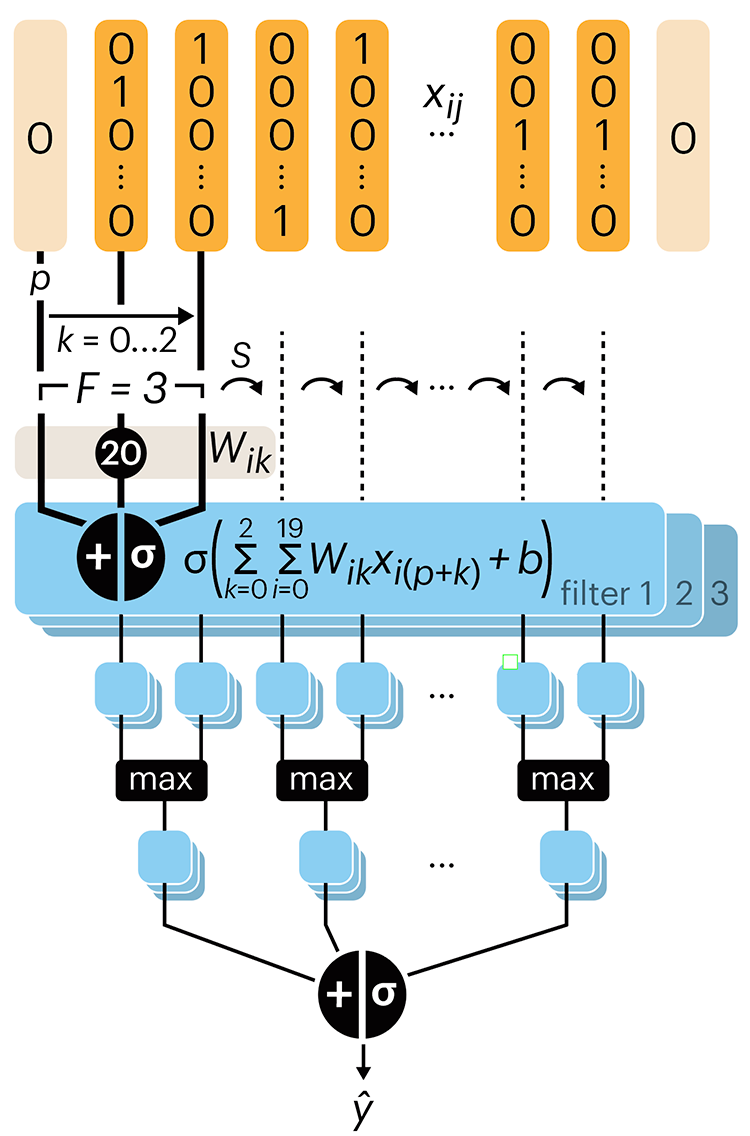
Even through convolutional networks have far fewer neurons that an FCN, they can perform substantially better for certain kinds of problems, such as sequence motif detection.
Derry, A., Krzywinski, M & Altman, N. (2023) Points of significance: Convolutional neural networks. Nature Methods 20:1269–1270.
Background reading
Derry, A., Krzywinski, M. & Altman, N. (2023) Points of significance: Neural network primer. Nature Methods 20:165–167.
Lever, J., Krzywinski, M. & Altman, N. (2016) Points of significance: Logistic regression. Nature Methods 13:541–542.



